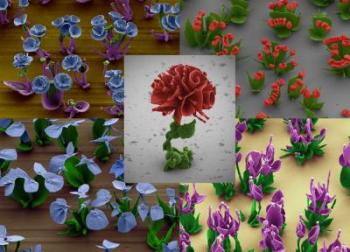May 17 2013
"Spring is like a perhaps hand," wrote the poet E. E. Cummings: "carefully / moving a perhaps / fraction of flower here placing / an inch of air there... / without breaking anything."
 These false-color SEM images reveal microscopic flower structures created by manipulating a chemical gradient to control crystalline self-assembly. Credit: Wim L. Noorduin, Harvard University
These false-color SEM images reveal microscopic flower structures created by manipulating a chemical gradient to control crystalline self-assembly. Credit: Wim L. Noorduin, Harvard University
With the hand of nature trained on a beaker of chemical fluid, the most delicate flower structures have been formed in a Harvard laboratory—and not at the scale of inches, but microns.
These minuscule sculptures, curved and delicate, don't resemble the cubic or jagged forms normally associated with crystals, though that's what they are. Rather, fields of carnations and marigolds seem to bloom from the surface of a submerged glass slide, assembling themselves a molecule at a time.
By simply manipulating chemical gradients in a beaker of fluid, Wim L. Noorduin, a postdoctoral fellow at the Harvard School of Engineering and Applied Sciences (SEAS) and lead author of a paper appearing on the cover of the May 17 issue of Science, has found that he can control the growth behavior of these crystals to create precisely tailored structures.
"For at least 200 years, people have been intrigued by how complex shapes could have evolved in nature. This work helps to demonstrate what's possible just through environmental, chemical changes," says Noorduin.
The precipitation of the crystals depends on a reaction of compounds that are diffusing through a liquid solution. The crystals grow toward or away from certain chemical gradients as the pH of the reaction shifts back and forth. The conditions of the reaction dictate whether the structure resembles broad, radiating leaves, a thin stem, or a rosette of petals.
It is not unusual for chemical gradients to influence growth in nature; for example, delicately curved marine shells form from calcium carbonate under water, and gradients of signaling molecules in a human embryo help set up the plan for the body. Similarly, Harvard biologist Howard Berg has shown that bacteria living in colonies can sense and react to plumes of chemicals from one another, which causes them to grow, as a colony, into intricate geometric patterns.
Replicating this type of effect in the laboratory was a matter of identifying a suitable chemical reaction and testing, again and again, how variables like the pH, temperature, and exposure to air might affect the nanoscale structures.
The project fits right in with the work of Joanna Aizenberg, an expert in biologically inspired materials science, biomineralization, and self-assembly, and principal investigator for this research.
Aizenberg is the Amy Smith Berylson Professor of Materials Science at Harvard SEAS, Professor of Chemistry and Chemical Biology in the Harvard Department of Chemistry and Chemical Biology, and a Core Faculty Member of the Wyss Institute for Biologically Inspired Engineering at Harvard.
Her recent work has included the invention of an extremely slippery material, inspired by the pitcher plant, and the discovery of how bacteria use their flagella to cling to the surfaces of medical implants.
"Our approach is to study biological systems, to think what they can do that we can't, and then to use these approaches to optimize existing technologies or create new ones," says Aizenberg. "Our vision really is to build as organisms do."
To create the flower structures, Noorduin and his colleagues dissolve barium chloride (a salt) and sodium silicate (also known as waterglass) into a beaker of water. Carbon dioxide from air naturally dissolves in the water, setting off a reaction which precipitates barium carbonate crystals. As a byproduct, it also lowers the pH of the solution immediately surrounding the crystals, which then triggers a reaction with the dissolved waterglass. This second reaction adds a layer of silica to the growing structures, uses up the acid from the solution, and allows the formation of barium carbonate crystals to continue.
"You can really collaborate with the self-assembly process," says Noorduin. "The precipitation happens spontaneously, but if you want to change something then you can just manipulate the conditions of the reaction and sculpt the forms while they're growing."
Increasing the concentration of carbon dioxide, for instance, helps to create 'broad-leafed' structures. Reversing the pH gradient at the right moment can create curved, ruffled structures.
Noorduin and his colleagues have grown the crystals on glass slides and metal blades; they've even grown a field of flowers in front of President Lincoln's seat on a one-cent coin.
"When you look through the electron microscope, it really feels a bit like you're diving in the ocean, seeing huge fields of coral and sponges," describes Noorduin. "Sometimes I forget to take images because it's so nice to explore."
In addition to her roles at Harvard SEAS, the Department of Chemistry and Chemical Biology, and the Wyss Institute, Joanna Aizenberg is Director of the Kavli Institute for Bionano Science and Technology at Harvard and Director of the Science Program at the Radcliffe Institute for Advanced Study.
Coauthors included Alison Grinthal, a research scientist at Harvard SEAS, and L. Mahadevan, who is the Lola England de Valpine Professor of Applied Mathematics at SEAS, Professor of Organismic and Evolutionary Biology and of Physics, and a Core Faculty Member at the Wyss Institute.